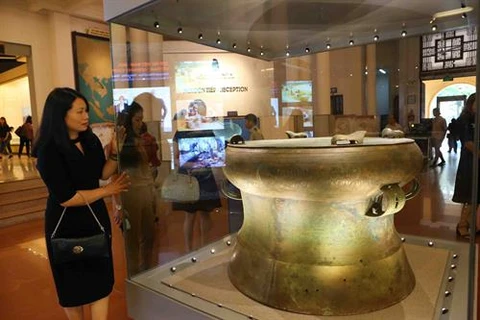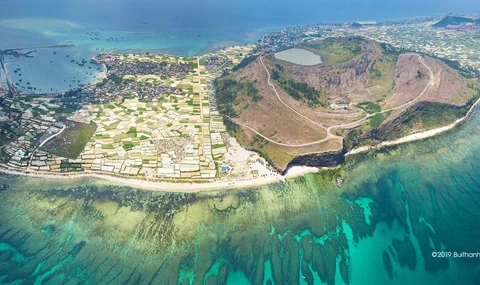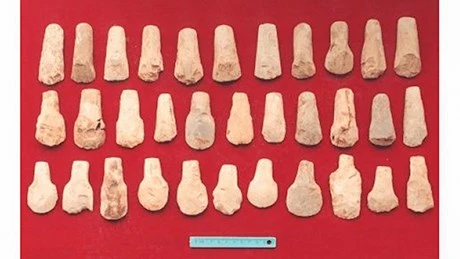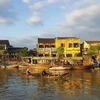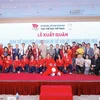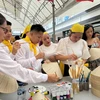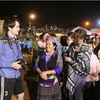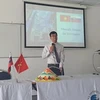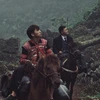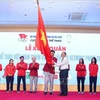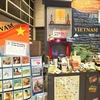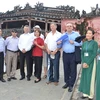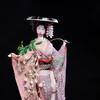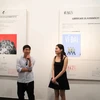
Hanoi (VNA) – The Bai Coi archaeological site is a relic cluster, including Bai Coi and surrounding places such as Bai Loi, Bai Phoi Phoi in Xuan Vien commune, Nghi Xuan district, Ha Tinh province.
The area is located at the foot of Hong Linh mountain, by the La river, the natural border between Nghe An and Ha Tinh provinces.
After many excavations conducted by archaeologists from Vietnam and the Republic of Korea (RoK), the site has been proven to have features of both Dong Son (800-200BC) and Sa Huynh (1,000-200BC) civilisations.
The site was recognised as a National Relic Site in 2014 by the Ministry of Culture, Sports and Tourism.
Nguyen Van Doan, Director of the Vietnam National Museum of History told VietnamPlus that the Dong Son civilisation was located from the Ngang Pass between Ha Tinh and Quang Binh provinces to the north while the Sa Huynh civilisation stretched from Quang Ngai province to southward.
However, discoveries at Bai Coi proved Ha Tinh is the meeting place of the two civilisations, he said.
“Findings at the site changed previous assumptions on the two civilisations,” he added. “Bai Coi has an important meaning in doing research on Vietnam’s early history.”
Journey to discover Bai Coi
In 1974, scientists from the Vietnam Archaeology Institute unearthed many stone and bronze objects here. They assumed the site hosted many objects in a large area, which might have been a tomb area of Dong culture.
The Vietnam National Museum of History and the Department of Culture, Sports and Tourism of Ha Tinh conducted excavations at the site in 2008 and 2009.
The first time, scientists gathered a large number of objects together with 16 tombs, which had features of the Sa Huynh civilisation but influenced by the Dong Son civilisation of around 1st-2nd century AD.
In late 2009, another excavation was conducted at the site on further areas at Bai Phoi Phoi, Bai Loi, Trang Van, and Phuc Da Temple, which unearthed 13 ancient tombs and buried objects.
The findings showed the tomb site was spread in a large area, which existed from some 300AD to the 1st century AD.
In 2012, the site was excavated once more by the Vietnam National Museum of History and the National Museum of Korean, which unveiled 15 more tombs and many buried objects.
All the objects were then transferred to the Republic of Korea for research and restoration, including metal objects like earrings, bracelets, axes, knives and hoes.
Archaeologists from the RoK discovered various kinds of fibres stuck on the surface of the metal objects, which led them to do further research on the weaving of early people, said Nguyen Manh Thang, head of the Research and Collecting Department of the Vietnam National Museum of History.
“Modern facilities and careful research process helped us define materials and forms of objects found. This is a focus of the cooperation programme between the two museums,” he said.
Exhibition featuring Bai Coi – a meeting place of civilisations
A unique exhibition is being held in downtown Hanoi by the Vietnam National Museum of History to provide scientific materials, which contribute to helping audience more understanding on the early history of Central Vietnam, including the Dong Son and Sa Huynh civilisations and their relations.
 A jar tomb - a popular burial form in the Sa Huynh civilisation displayed at the exhibition helps the audience imagine the site in early history. (Photo: VietnamPlus)
A jar tomb - a popular burial form in the Sa Huynh civilisation displayed at the exhibition helps the audience imagine the site in early history. (Photo: VietnamPlus)
The exhibition, which opened on November 18, displays more than 15 objects and documents in various materials like stone, ceramic, metal and glass.
Bai Coi is a complex of tombs scattered in a large area with two forms of tombs, namely bodies buried in soil and bodies buried in ceramic jars.
Thang said ceramic jars in Bai Coi are of smaller size than those in Sa Huynh, Quang Ngai.
Soil tombs here have a later date compared jar ones. Scientist found here many soil tombs cut across jar tombs, which had been buried before.
The exhibition will run at the Vietnam National Museum of History, Hanoi, till the end of April next year./.


